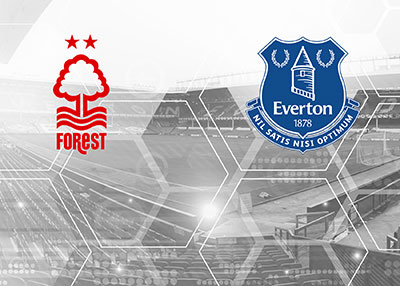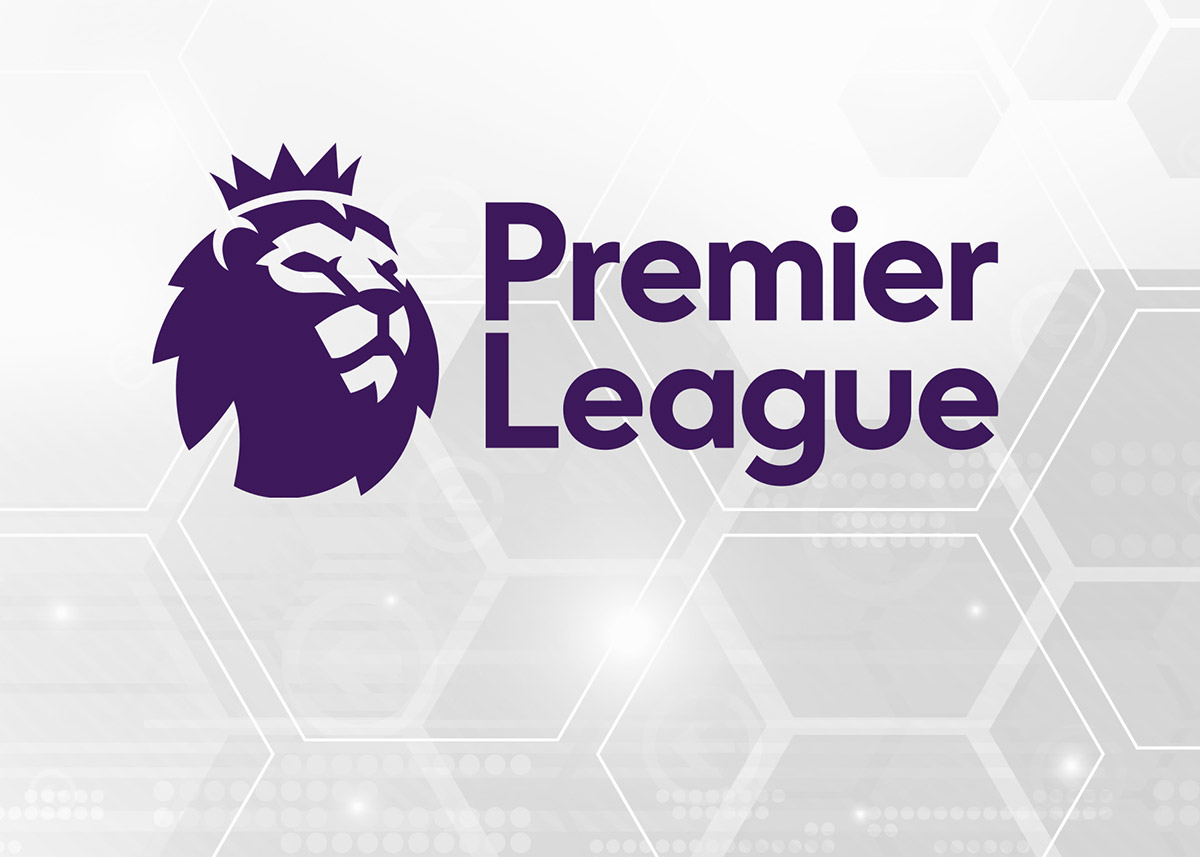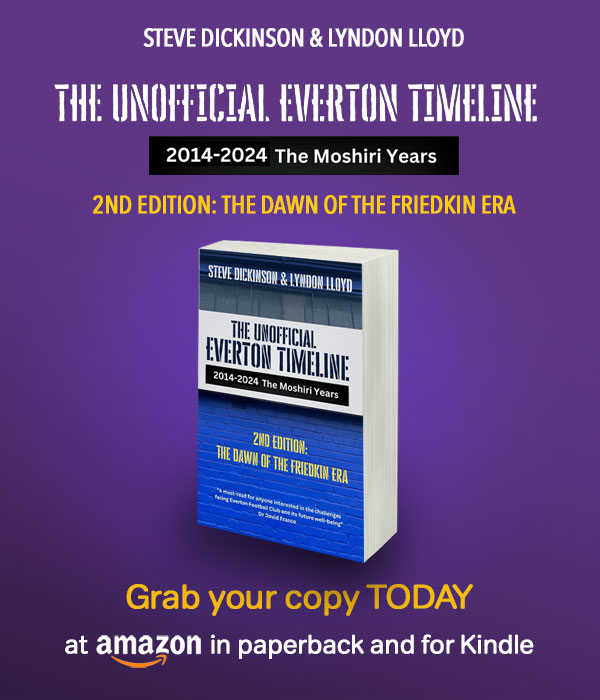Match Report
The Blues were trailing 1-0 to Nick Blackman's first-half strike with more than an hour of the contest gone and little sign at that point of the kind of fightback that carried them past Barnsley in the previous round.
Barkley smashed home the equaliser in the 62nd minute, however, and then drew the free kick from Michael Hector from which Deulofeu scored via the hands of Ali Al Habsi to give Everton a lead they didn't relinquish.
Playing in an unorthodox line-up with a three-man back line, Aaron Lennon as an unconvincing wingback and Deulofeu seemingly in a floating role ahead of Leon Osman and James McCarthy in midfield, Everton started brightly and created a chance for Arouna Kone after 10 minutes that the Ivorian scuffed weakly wide.
That early momentum subsided, however, as the Blues' performance went a little flat and their Championship hosts came into the contest more as the first half wore on. Joel Robles had to make an excellent one-handed save to push Blackman's fierce 18-yard shot over the bar before the in-form Reading striker was almost put in by an incisive move but his shot was charged down at the last second. Another hammered shot goalwards saw the Spanish 'keeper fist the ball awkwardly away 10 minutes before the break.
The Royals took the lead a minute later, though, when Ola John whipped a cross in from the left that Blackman swept home as Funes Mori tried to hook it away at the back post and the ball flew into the roof of the net.
Everton responded with a corner that fell to Lukaku but his shot from close range was blocked behind and appeals for a penalty on Deulofeu were waved away a few minutes later as he went down in the box between two defenders.
Kone was withdrawn at half time by Martinez and the Blues were forced into another change almost immediately when John Stones was taken off with an injury to be replaced by Galloway.
Thanks to Barry's more assertive presence in the middle, Everton began to look far more authoritative but too many hopeful passes towards the subdued Lukaku and the mercurial Deulofeu meant that they were lacking potency going forward.
John fired over as Reading looked to extend their lead while Barkey popped up in the opposition box but couldn't beat his marker with a centre looking for Lukaku near the six-yard box.
Everton maintained the possession, though, and when a Deulofeu corner was cleared to Barkley, the 21-year-old smashed a left-footed volley past Al-Habsi to level the tie in the 62nd minute.
10 minutes later it was 2-1 when Barkley was flattened in full flight by Michael Hector and Deulofeu powered a free kick from 30 yards that Al-Habsi could only push into his side-netting.
The ex-Wigan goalkeeper atoned somewhat a few minutes later when Lukaku was put through in the clear by Deulofeu's clever pass and he came out quickly to intercept before the Belgian could take it around him.
Reading rallied as the game entered the final 10 minutes and they had Robles scrambling to his left post as a deflected shot from Tshibola dribbled wide and back-to-back corners were dealt with by the Toffees' defence.
Substitute Danny Williams tried his luck from outside the box with an injury-time effort that comfortably cleared Robles's bar.
Ultimately, while it was an underwhelming display by the Blues, they had enough quality in Barkley and Deulofeu to get the job done and secure passage to the fourth round after three successive exits at this stage of the competition.
The Spaniard was the difference-maker off the bench against Barnsley in the previous round and though not everything worked for him here at the Madjeski Stadium, he and Barkley always looked the most likely to turn the tide in Everton's favour.
In terms of impact off the bench this time, much credit should be given to Barry who transformed what was a fairly directionless performance into a far more cohesive showing in midfield.
Match Preview
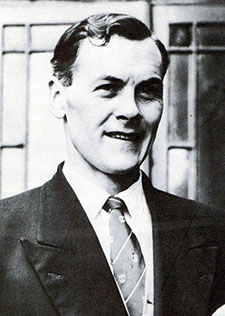
Ian Buchan circa 1957
22 September 2015 marks the 50th anniversary of the death of Ian Buchan who, in between the Cliff Britton and Johnny Carey regimes, oversaw Everton’s first team for a shade over two seasons. Often overlooked, his posthumous pen-portraits have been cursory. So who was Ian Buchan?
John Cameron Buchan was born on 20 June 1926. Always known as Ian, he grew up in Riddrie, a working-class community to the east of Glasgow. His father, George, owned a shop. Whilst George was of an easy-going nature, his wife, Agnes, was more strong-willed. In earlier life, George had participated in long-distance walking to quite a high level. Although Ian had an elder sister, Betty, he was, by most accounts, the apple of his parents’ eyes.
Ian always took a keen interest in sport with football his particular passion. Twice he attended trials with his favourite team, Glasgow Rangers, but on both occasions he was knocked out in aerial challenges. He was subsequently registered with Third Lanark from 1942 to 1946 but it is unclear if he played for the first team. Several 1950s newspaper articles stated that he had played for Queens Park, the famous amateur Hampden Park-based club. There is no record of him appearing for the Spiders’ first team but it is possible that he turned out for the Strollers (reserves) or the Hampden XI (who played in Saturday amateur leagues). Ian was also reported to have been selected as a reserve forward for the Scottish amateur team on five occasions. Formal amateur international fixtures had been suspended between the outbreak of war in 1939 and March 1949 so these selections may have been for unofficial fixtures.
During the Second World War, Ian became a parachute instructor and became quite addicted to the pursuit. He studied physical instruction and gained employment teaching PE at Sir John Maxwell Primary School in Pollockshaws (South Glasgow). Joe Davis, who went on to play at left-back at Hibernian under Jock Stein, recalls Ian making him captain of the school football team which won the area cup in 1951. Ian met his future wife, Margaret “Rita” MacAlister, through work as she was also a PE teacher — they wed on 8 July 1954 at Mosspark Church. Both were evangelical about the joy of sport and helping people to work properly with the body they were given.
Ian was ambitious and willing to take risks. In 1953, he accepted a post lecturing in sport at Loughborough College. The Leicestershire town has a tradition of excellence in sports science. The University, which was spawned by the College, has been attended by the likes of Bob Wilson, Seb Coe and Tanni Gray-Thomson. Ian’s specialist area was kinesiology — the science of human movement. He had received FA coaching and physiotherapy qualifications and, in his new role, prepared students for careers as PE teachers and physical training instructors.
Two of his students, Hugh Barr and Mike Greenwood, would go on to represent Great Britain in football at the 1960 Rome Olympics. Greenwood recalls: “Ian was a no-nonsense person. He wasn’t brutal but at the same time he had the attitude of ‘you mess about with me and I’ll mess about with you’. He was, however, a very understanding person and was highly regarded within the college.”
In February 1956, Everton had parted company with General Manager Cliff Britton in acrimonious circumstances. With Dick Searle replacing Ernest Green as the club’s Chairman, the Board of Directors resolved not to appoint a manager ever again — preferring to retain the powers it had enjoyed before Britton’s appointment in 1948. Scores of applications were received for the vacant post but the five candidates short-listed for interview in early May were Ian Buchan, former Everton half-backs TG Jones and Maurice Lindley, Luton Town coach Harry Wright, and former England international George Hardwick. Ultimately the directors chose the Scot, offering him a two-year deal at £1,250 per annum. The board minutes recorded: In accepting the appointment, Mr. Buchan thanked the Directors for the confidence shown in him, and said he would do his utmost in the interests of the Club.
The left-field appointment of a man without a professional playing or managerial background came as a shock to anyone outside the boardroom. So why was Ian selected? Family recollections suggest that a tip-off about the job had been given so perhaps Ian’s work at Loughborough had come to the attention of someone on Merseyside. Clearly Ian impressed the parsimonious board with his promise to make the Everton players the fittest in the land — thereby raising performance levels without the need for a significant outlay on player acquisitions. After his appointment, Ian told the journalist Don Hardisty: “I don’t think the players of any professional club in the country have yet even approached the peak of physical fitness.” When asked by Hardisty if, as an unknown quantity, he might find it hard to win over supporters, he replied: “I didn’t apply for this job without a great deal of thought. Now I will let results speak for themselves.”
The directors offered Ian the lease on Number 1, Earls Close in Crosby — a phone connection was thrown-in. The house had previously been occupied by Harry Potts who had been Cliff Britton’s ill-fated big-money signing for the club.
Having finished his duties at Loughborough, Ian eschewed a summer break and commenced work at Goodison just three days later, on 14 July 1956. Rita was less enamoured than her husband with the idea of swapping the stability of Loughborough for the cut and thrust of the football coal-face. Nonetheless, she supported Ian to the hilt once the decision was made.
Ian was given the title of Everton’s “Chief Coach”, the exact responsibilities of which were still being defined and refined after the 1956-57 league campaign had commenced. In September, the board decided that Ian would train the first team but many other matters, including transfer activity, appeared to remain under the control of the board. It was also decided by the directorate that the new coach could watch matches from the Directors’ Box.
The team Ian inherited was still in the doldrums after three seasons spent in the Second Division (promotion was achieved in 1954). The ageing squad was in need of overhaul but the transfer pot was empty. First-team stalwarts Cyril Lello and Nobby Fielding were six years older than the 30-year-old coach. Although Lello would move on to Rochdale after only 5 games under the new regime, Fielding would play a significant role on the pitch throughout Ian’s tenure. Ian met the players (fatigued after a summer tour to the USA) for the first time on 18 July with club directors and the local press corps in attendance. “Ranger” (Bob Prole) of the Liverpool Echo reported:
Mr. Ian Buchan, at the request of the chairman, addressed a few remarks to the players. He was, he said, both gratified and proud to be associated with a club of Everton’s traditions. To make sure of a successful season he would need 100 per cent co-operation from all the players. He felt sure that would be forthcoming and that they would all pull together for the good of Everton. On behalf of his colleagues skipper Peter Farrell extended a warm welcome to Mr. Buchan, assured him of the wholehearted co-operated he had just asked for, and wished him a long and happy career with the club.
A few weeks into his tenure, Ian commented to Ranger on the positive attitude of the players which he’d encountered: “They are determined to achieve the peak of condition and equally resolved to do well on the field of play which is the vital thing.” He went on to explain the scientific approach to preparation for the coming season: “The purpose of the initial training of the past ten days has been to achieve basic fitness. That is the solid foundation on which I hope to build their speed. Later on we shall go into other matters, such as the tactics to be employed, the varying strategies during individual games, and so on.”
Ian went on to advise Ranger that soccer success is made up of “90 percent perspiration and 10 percent inspiration”. He explained that his aim was to provide an infinite variety of tasks for the players to tackle so that they never lost interest. Training was to be geared to the capacity of each individual with no-one being asked to attempt things beyond his ability merely because somebody else could do them.
Ian concluded by stating: “We are aiming at a happy and sound team spirit and I am sure we shall achieve it. The players are co-operating wonderfully well and realize that not only myself but everybody connected with the club is anxious for their well-being and future success.”
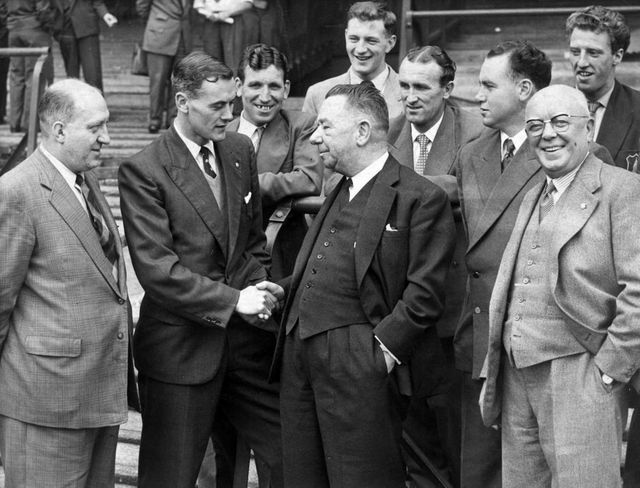
Ian’s first competitive match was on 18 August 1956 at Elland Road. In an attempt at mind-games, Ian instructed the coach driver to stop a mile and a half short of the ground so that the Leeds players would be intimidated by the sight of the visitors arriving at a canter on foot. The plan backfired – Wally Fielding described the players as “knackered” as they fell to a 5-1 defeat.
A debut victory was finally achieved at home to Burnley on 12 September – a week later the board resolved that: The Chief Coach presents on paper to the Board each weekly Board meeting his suggested 1st and 2nd Teams for the next match, and the Board agrees to accept these teams in their entirety. Over time, the Directors eroded Ian’s autonomy in team selection. Board meeting minutes from January 1957 recorded: It was agreed that Mr. Buchan present his teams personally each week, after the Board meeting had closed, when any comments could be made. A further indication of the way in which Ian’s authority was impinged on by the board was a minute of the Playing Sub-Committee from April 1957: TEAM SELECTION: It was resolved that the Sub-Committee inform Mr. Buchan that it is the wish of the Board to play some of the younger players in the 1st Team as soon as possible.
The day before the Burnley fixture in September 1956, Ian presented a memorandum to the board. This “special report” assessed that state of the playing staff (which consisted of 52 professionals) and made proposals to address issues highlighted. Ian stated that the existing playing squad lacked the quality to compete at the highest level and he put forward two alternative remedial strategies. The first was for the board to make significant outlays on established forwards such as Fulham’s Johnny Haynes and Sheffield Wednesday’s Albert Quixall. The second option was to blood youngsters in the hope, and expectation, that the experience given to them would prove useful in the medium term even if short-term might be arduous. Ian recommended the latter, stating:
By this method, although we may have a very lean season, we shall have found our way out of the woods and the green fields of opportunity and success will lie at the feet of men who are young and virile enough to take full advantage of this.
The board concurred and rubber-stamped Ian’s plan to blood youth and gain an advantage through levels of fitness superior to those of opposing teams. Indeed, teams fielded during the Buchan regime had often cost less than £100 to assemble. During the close-season a new, cutting edge, gymnasium was installed under the corner of the Gwlady’s Street and Bullens Road stands at a cost of £2,500. Press reports noted that the gym boasted “special air conditioning”, “fluorescent lighting” and a splinter-free Danish beech wood floor. Ian was determined to get good value from the investment.
Club captain Peter Farrell touched on the new fitness regime and facilities in his regular column in the Liverpool Echo:
During the past four weeks, under our new coach Ian Buchan, all the boys at Goodison have undergone a very strenuous yet interesting schedule of training. In our new gymnasium under the Gwladys Street Stand we have shed quite a lot of perspiration in our circuit training and weight-lifting. We have also devoted much time endeavouring to speed up our movement in this respect with the aid of the stop watch. Mr. Buchan and his staff discovered that we have quite a few speed merchants in our ranks, and one morning Jimmy Harris, the fastest man on the books, clocked 10 seconds for 100 yards.
Brian Labone, Mick Meagan and Derek Temple, who would taste glory in the 1960s, made their debuts under Ian. The latter recalls: “It was a strange appointment but I really liked Ian, he was a nice man. He was a great bloke but not cut out to be the manager of a big club. He gave me my debut and he told me that I’d play for England and he was proved right – I played once! He built a state-of-the-art gym – it was all circuit training against the clock and weights which we had never been heard. He had us so fit but some of the older lads like Nobby Fielding complained!”
Meagan, who made his first team debut in August 1957 after five years on the sidelines, continues: “Ian didn’t seem like a real footballing type — he could have been a business man. He was a lovely man but maybe a bit too nice to deal with the pressure of football. He was a keep-fit merchant. He was the first man to bring in weight training in the gym. It was very good for guys who myself who were small. We had lunch at the ground in those days and the meals we had were fantastic with the best steak. He’d come up to you and say, ‘Did you get enough steak?’ Ian was very concerned that you needed this grub to keep going — he had this vision of building us up into monsters!”
Installed to work alongside Ian as assistant coach was Harry Wright who had been pipped to the Chief Coach role — presumably Ian had little input in the appointment. Wright had previously been an army PT instructor at Aldershot and was noted for his film-star looks. Mick Meagan recalls: “Harry Wright was some character, he was the image of Clark Cable and he knew it! He used to wear lovely Donegal tweed suits. The trainer in those days would help with the team gear in the big skip — pushing it at the likes of Euston Station. But that wasn’t Harry’s thing. He suggested that we bring two reserve young lads to give them experience of mixing with them the first team but they ended up pushing the skip — not Harry! He was a big man and loved the hotels and all the attention!”
As might be expected with a transitional team lacking quality and experience, the 1956-57 season proved difficult but the 14 victories and 10 draws were enough to secure a mid-table 15th place finish. A rare highlight was a thumping victory at Old Trafford. The Buchans worked as a partnership with Rita attending reserve matches whilst Ian was at first-team fixtures — and vice-versa. After the match at Old Trafford, Rita advised her husband of the 5-2 scoreline. Ian consoled himself out loud that the Blues had managed to score two goals before Rita corrected him that Everton were the victors.
Ian’s second season saw the return of fans’ favourite Dave Hickson from Bill Shankly’s Huddersfield Town for £6,500. Jimmy Harris switched from centre-forward to outside-right to accommodate the Cannonball Kid; Derek Temple established himself at inside-forward, and Mick Meagan finally broke through at left-half. Temple made his debut at centre-forward against Newcastle in March 1957.
In October of the same year, Ian accompanied him to London when he played for England Under-20s against Romania at Stamford Bridge. The trip was most memorable for the return journey as Temple recalls: “We had won about 4-2. After the game, Ian said to me, ‘Come on we’re going – we have a game coming up and I want you back.’ I said, ‘OK but there are two lads here that need a lift if you don’t mind Boss?’ They were Wilf McGuinness and Jimmy Melia. Ian had an Austin Cambridge, and he had his wife with him — a nice lady. I was terrified by his driving — foot down and then braking. He had two smashes in Birkenhead — I was glad to get out at the end.”
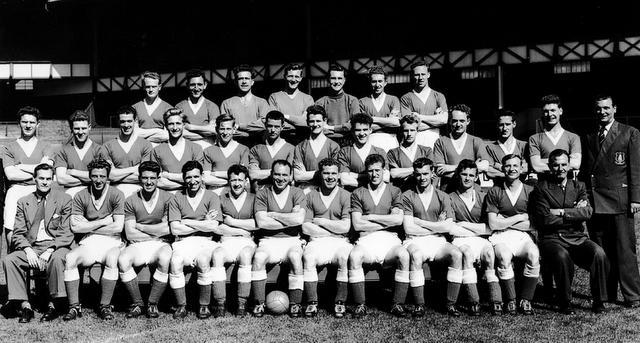
Everton squad photographed in the summer of 1957. Ian seated far left
During the summer of 1957, the Everton training team of Harry Wright, Gordon Watson, and Stan Bentham spent a week at the Lilleshall centre of the Central Council for Physical Recreation. Here they attended a course in the latest methods of training coaching and treatment of injuries — it is reasonable to conclude that this was at Ian’s behest. Wally Fielding was also there, taking the first steps on the road to a potential career as a coach. Back at Goodison and Bellefield, the new season was preceded by the now customary Buchan regime of training – albeit, Ian told Ranger, with a greater emphasis on shooting, heading, dribbling, trapping and so on. Newly re-signed Dave Hickson commented on the training programme in his Liverpool Echo column:
Under the guidance of our chief coach Mr. Ian Buchan, I feel – apart from the temporary stiffness, which will soon wear off – fitter and better than for many a long day. My former colleagues, who have been through it all before and speak highly of the system, have told me how much it has improved their fitness and staying power in the past. I can quite believe it. The weight-training system for the strengthening of muscles in all parts of the body – arms, legs abdomen, back and so on – is strenuous, but I am sure it will do me, as it has done the others, a world of good. Unless I am very much mistaken we are going to be one of the fittest teams in the country, and far more able to stand a grueling ninety minutes than the majority of our opponents
In spite of Hickson’s optimism, local journalists were filled with foreboding for the approaching 1957-58 season. Leslie Edwards of the Daily Post wrote: Even allowing for Dave Hickson’s return, I suggest that this may prove one of the most difficult of Everton seasons — and we have endured some pretty indifferent ones since the war. Ranger in the Echo concurred: The man I envy least of all is Mr. Ian Buchan, who apparently is expected to make bricks without much straw. He is doing as good a job as possible with the limited staff and limited powers. I wish him the best of luck.
Confounding the portents of doom, the season started promisingly with Everton in the top ten until late autumn. The early season promise saw Ian awarded with a three-year extension to his contract in January 1958. A month later, as form ebbed away, the directors chose to dilute Ian’s authority further by insisting that he could submit his team sheets at noon on Wednesday after taking on board the opinions of the directors. Eighteen-year-old Brian Labone was blooded at centre-half in March - the first of his 451 league appearances. Victories on the final two games of the season gave the gloss of a 14th-place finish. In an article published at the end of the season, Ian put forward his reasoning for the dip in form as the season progressed:
Our team this season has largely been comprised of youngsters inexperienced in the demands of First Division football. This has to be expected and viewed as part of their apprenticeship where they gain that invaluable part of football — experience. I firmly believe that they will be all the better for it.
At the beginning of the season, there was plenty of grass on the pitches and the style of football which we adopted – namely a fast-flowing teams which relies mainly of moving the ball about first time — proved highly successful. But with heavier going (pitches) we suffered a great deal. I shall not rest until I am satisfied that we have a more flexible approach to the game and are able to adapt our style to suit the conditions.
Mick Meagan recalls that Ian’s focus on fitness may, ultimately, have become a hindrance rather than a help: “Instead of staying at a level, he kept building on the weights until it got to the point where we couldn’t lift them. When we hit the bad spell, it got into Ian’s head that by adding more weights it would make us stronger — like gladiators. It had the opposite effect on our performances — we were knackered and it backfired on us. That was the start of the downward trend with Everton.” Derek Temple recalls the impact the pressure of the role had on Ian: “He didn’t half age. He had looked the part but he started getting black under his eyes and his hair went from black to grey.”
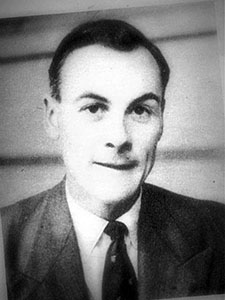
Ian photographed in 1958
Ian’s third season started disastrously with five consecutive defeats. A 6-1 home humbling by Arsenal on 6 September 1958 was to prove the final straw. At half-time, fans turned on the Directors’ Box and started chanting “We want a team”. Chairman Dick Searle saw fit to publicly criticise the fitness of the players. Two days later, Ian had to face the assembled board members who proposed drastic changes to the coaching setup. Gordon Watson was promoted to first team trainer and Harry Wright — apparently under a cloud — was demoted to coaching the juniors. Ian’s own position appeared to be uncertain as the minutes noted: Mr. Buchan stated that, in his opinion, the proposed changes would not solve any of the present problems. The question of the relative positions of Messrs. I.C. Buchan and A.W. Fielding re. tactical training was deferred for discussion next week. Publicly the board merely was more opaque and issued the following statement: “The directors are in complete harmony regarding the steps to be taken to remedy the present situation.”
At the subsequent board meeting it was agreed that: The appointment of a Team Manager with playing experience of 1st Division professional football is expedient in the present circumstances. This was tacit acknowledgement that the gamble taken on installing a Chief Coach in lieu of a manager had failed. On 23 September, the news broke that Blackburn Rovers’ manager John Carey, the former Manchester United captain, had agreed in principal to become Everton’s team manager. Carey, offered a five-year contract with a salary of £3,000 per annum, insisted that he would have “full control of playing staff, training staff and scouting, subject to the overriding authority of the Board.” This was in stark contrast to Ian who, the board minutes suggest, had been treated almost as a gofer by some directors.
Ian continued in his role whilst Carey’s appointment was finalised and the Irishman worked his notice. One of his final acts was to go to Glasgow to help negotiate the transfer of Bobby Collins from Celtic. Collins was dumbstruck when he learnt, in conversation, that his brother, Archie, had been taught PE at school by Ian. Collins made an immediate impact on the pitch — scoring on his debut in the team’s first win of the season. His winning mentality and footballing ability would almost single-handedly drag Everton out of relegation trouble. Sadly the inspirational Collins’s arrival was too late to save Ian. When Carey commenced his duties at Goodison in mid-October, a handover meeting was held with Ian. Subsequently the in-limbo Scot was given a two-week leave of absence — ostensibly to avoid an awkward state of affairs for all concerned. In his biography Collins compared the two men: “Ian Buchan knew the game but he was too much of a theorist, having never played the game at the top level. Johnny, on the other hand, had a wealth of experience and understood players more.”
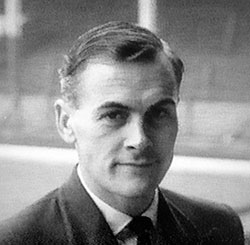
Ian being interviewed on TV
Local journalists speculated that Ian might continue on the Goodison staff under Carey. For a period, he worked with the youth players but it soon became clear that his time was coming to an end. With little sentiment, the directors elected to cease footing the bill for Ian’s phone calls and his car allowance on 4 November 1958. With Rita hospitalised for a number of weeks following the arrival of the Buchans’ baby daughter, Ian had to break the news that he had been displaced by the appointment of Carey. At this time, an offer to coach the national team of Turkey was on the table. Ian did not dismiss this proposal out of hand but Rita, the more practical and risk-averse of the two, insisted that her husband seek a more stable occupation which would support the growing family.
It would be the following spring before E Holland-Hughes (the future Everton Chairman) and Ian’s solicitors reached a final severance settlement. Compensation of £1,600 was paid in lieu of contracted salary payments up until July 1961. The parties agreed for Ian to purchase the club house in Crosby in October 1959.
Ian found employment with Littlewoods in Liverpool. It is highly likely that the increasingly influential John Moores had a hand in the appointment. Mick Meagan recalls coming across his former coach: “Football can be a sad game. Four or five of us used to go into town for lunch on a Friday. One day we went into Littlewoods and there was Ian working. It was sad to see him as a few months earlier he had been our boss. It was so hard to go over — you didn’t know what to do because he was a very nice person. But we did go over and it was the usual ‘hellos’. He said that he was delighted that we were doing well and said ‘Don’t forget that you are my boys.’ That was the last time I saw Ian.”
Subsequently Ian worked in Berkshire in sales for a pharmaceutical company — family members recall that he could be charismatic and good in terms of selling ideas to people. In 1963, the family returned to Scotland, living at Bridge of Weir in Renfrewshire, as Ian took up a post with the Peter Stuyvesant tobacco company. He would rise to become head of sales in the Scottish region. Despite the career change, Ian never lost his love of sport; he encouraged his employer to become involved in sponsoring Scottish skiing whilst tentative, but abortive, discussions were held about him appearing on BBC Scotland’s Sports Scene.
In the early hours of 22 September 1965, Ian was driving home in his Ford Zephyr when the car left the road and hit a lamppost. No other vehicle appeared to have been involved in the incident. When the emergency services extricated Ian from the vehicle, they took him to the Southern General Hospital in Govan where his death was confirmed. He left behind Rita, who would outlive him by 50 years and his 7-year-old daughter. Many reports of his passing gave his age as 45 – an error repeated in most subsequent articles. In fact he was still nine months short of his 40th birthday.
In the intervening years, Ian has faded from memories of most connected with the game. Looking back, his appointment at Everton can be viewed as an inadvertently forward-thinking one by an ultra-conservative club hierarchy. The current-day European model of football management sees coaches employed to focus on the teams whilst executive board members take care of the wider aspects of club administration and transfer policy. Certainly Ian’s scientific approach to conditioning and fitness, although perhaps taken to extremes, would not seem out of place in a modern football environment. Perhaps if Everton had chosen a suitably qualified “football man” to work alongside Ian, and invested in several top-class players, things might have panned out very differently.
» Read more: Ian Buchan – Everton's Forgotten Manager (Liverpool Echo)
Acknowledgements:
The Buchan Family
John Litster – author of an excellent article in Scottish Football Historian (Issue 125)
George Orr
Billy Smith (Merseyside press articles on bluecorrespondent.co.uk)
Mick Meagan
Derek Temple
Jimmy Harris
Alan Rhodes (Queens Park historian)
Bert Bell (Third Lanark historian)
Douglas Gorman
Various Everton history books
Bobby Collins – The Wee Barra by David Saffer
The Everton Collection (board minutes)
Joe Davis
* Unfortunately, we cannot control other sites' content policies and therefore cannot guarantee that links to external reports will remain active.


